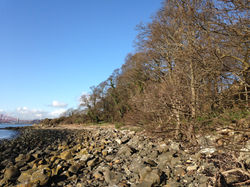Early Butterflies in the sunshine
As I am sure you will have noticed, it is not just bumblebees that are now around our gardens and wildflowers. There are some very colourful butterflies around too. Small Tortoiseshell and Peacock, also spend the winter in hibernation as adults, but unlike the bumblebee queens that dig a chamber underground, these butterflies seek out sheltered dry places; under fallen trees; in cavities in old stone walls; or in sheds or garages - more used in the past when doors did not fit so tightly.

Two of the ones you are most likely to see are Small Tortoiseshell and Peacock. If the wings are closed, both look dark with camouflage patterning, but when they open the wings to get the warming sun directly onto their bodies, you can fully appreciate the brilliance of their colourful upper wing surfaces. Both these photos were taken just a few days ago.

They have now been around for the last couple of weeks, making the most of days with warm sunshine which provide an opportunity to find sources of nectar to fuel their flights to find mates and lay eggs. Dandelions are an excellent flower for nectar and these two species are tapping into the energy rich nectar in photos taken in springtime in previous years.

They can be harder to see close up than some of the other insects that are around, as they are very good at spotting movement and fly off rapidly when they think there might be a threat of being caught by a predator. You may also note that the wings can sometimes look quite tatty round the rear margins, an indication that some might have had a narrow escape from such an encounter, or it may simply be a legacy from getting a bit battered as they leave tight hibernation spaces.

They will hopefully find suitable stinging nettles on which to lay their eggs-we have a lot of them around the woodlands - but they are said to prefer nettles in sunnier aspects for their caterpillars to feed on. The next generation of adults from these caterpillars should be on the wing from July onwards and their colours will be brighter when they first emerge.







































